6 groups that make a difference in our community
stories by Judy Ross, Emily Worts, Janet Lees
photography by Jessica Crandlemire
People are the foundation of the lifestyle that makes Southern Georgian Bay so special, and we can lay claim to having some of the best within our midst.In each community, small groups of people quietly but persistently go about making a positive impact. In many cases, no one person can be singled out – it is a team effort.
On The Bay honours six local groups made up of extraordinary people from all walks of life who have banded together to make a difference that will be felt for years to come. We should be proud to call them our neighbours and friends.
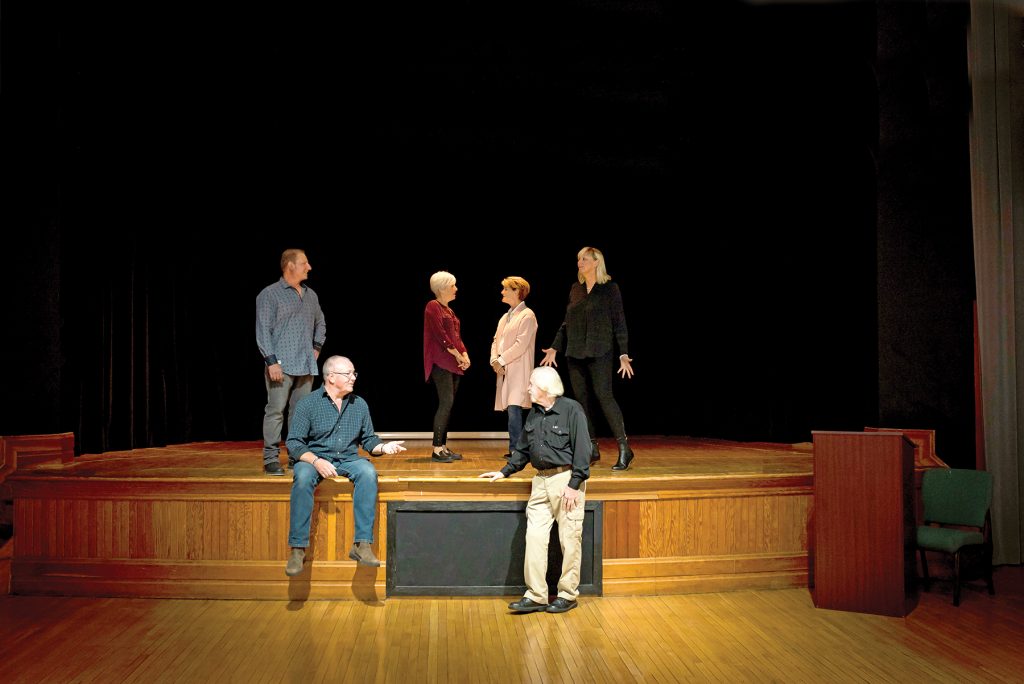
The Marsh Street Centre
If communities really do have a heart, then the Marsh Street Centre in Clarksburg is a fine example. This limestone structure has stood in the heart of the village since 1927 and was a hub of community activity from the outset, serving as a venue for ballroom dances, a municipal office and a military museum. Then, in 1997, a group of local citizens and arts groups purchased the property from the town in order to provide a home for the local theatre troupe and a meeting place for the community.
Since then it has been run as a not-for-profit organization funded by memberships, donations and grants. There have been countless fundraisers and the building itself has been renovated and updated from top to bottom. Every day of the week the centre resonates with sounds of happy activities: a group of artists working at easels in the auditorium, budding young rock musicians rehearsing in the studio, a coffee group gathering on the patio.
The latest addition to the roster is Marsh Street Acts, a new program run by local entertainer Dean Hollin that gives students the opportunity to experience every aspect of theatrical stage craft, from performing to creating props, sets and costumes, stage managing or providing lighting and sound. With programs like this and Marsh Street Rocks, an innovative music program for kids, new generations are being introduced to the arts and the wonders of community.
“The amazing thing,” says Steve Gorton, a retired pilot who became president of the Marsh Street Centre board of directors last year, “is that it is completely owned and operated by volunteers. It only exists because of the hard work of volunteers. We average over 5,800 volunteer hours per year.” And those volunteers are a hard-working group. Apart from ongoing fundraising activities, they pitch in wherever needed.
One of the joys of volunteering at “The Marsh,” as it is affectionately known, is the variety of opportunities. When Gorton began living full-time in Thornbury five years ago and was looking to volunteer, he chose The Marsh partly because of this variety. “There’s a role for everyone, from maintaining the garden, to doing touch-up paint jobs, to putting up posters for events, to serving turkey at the annual Christmas dinner,” he says. “It’s almost never routine and it’s a lot of fun!”
The board of directors consists of 10 ‘hands-on’ volunteers who serve four-year terms. For many of them The Marsh becomes almost a second home, and there’s a sense among this group that the centre has been going from strength to strength in the past five years or so. As Gorton points out, “I think we’re achieving what those original founders had in mind.” And the community reaps the benefits.
by Judy Ross
To find out more, visit marshstreetcentre.com

Blue Mountains Attainable
Housing Corporation
In any community, and particularly those with a tourism sector, housing for service-sector employees, young families and seniors on a modest income is essential. In Southern Georgian Bay, the rising demand for premium real estate, secondary homes and short-term accommodation is keeping this segment of the population out of the real estate market, yet without them it’s impossible to have a complete, healthy and functioning community.
This desire to keep employees living in the community led the Town of The Blue Mountains to form a not-for-profit corporation in 2014 to augment the supply of sustainable housing units. The Blue Mountains Attainable Housing Corporation (BMAHC) operates as a committee of council, with a volunteer board of five full-time residents and two members of council. Over the past five years, this innovative approach has been making small strides toward a solution.
“When I retired here, I could see there was a need for this type of housing,” says Janet Findlay, a BMAHC board member with a background in community housing in the GTA. “We have been making some progress, but it took a civic election last fall to bring the issue to the forefront. We elected a council with a strong mandate to deal with attainable housing. It’s much more exciting now because there’s a real feeling that things are possible.”
With 2.5 million visitors a year, the demand for services in The Blue Mountains is higher than places where the population is more static, and housing for service workers is essential (attainable housing is distinguished from affordable housing, which is the responsibility of Grey County and applies to individuals and families receiving income support). “Our focus,” offers Findlay, “is to provide modest-cost housing (either rented or owned) that is built by the corporation and protected from market forces in perpetuity.”
When researching ideas for this type of housing, the committee looked to The Whistler Housing Authority in British Columbia, which owns and operates 1,900 units of rental and ownership housing and is considered a model for achieving attainable housing in a resort town. However, a movement like this requires patience and creative thinking. Currently, the BMAHC is approaching developers to partner with them. “We really need to offer incentives to make it interesting for the private sector; that’s one of our big challenges,” notes Findlay.
There is a renewed feeling of optimism now that the Town of The Blue Mountains has purchased the former Foodland site in Thornbury with the goal of building high-density apartments on the property. “We’re hoping for shovels in the ground by next spring,” says Rob Sampson, chair of the BMAHC. A newly elected councillor, Sampson ran on an attainable housing platform and has been a driving force behind moving the effort forward. “We’re approaching this issue with a degree of urgency,” he explains. “We don’t have time to wait.”
by Judy Ross
For more information, visit thebluemountainshousing.ca
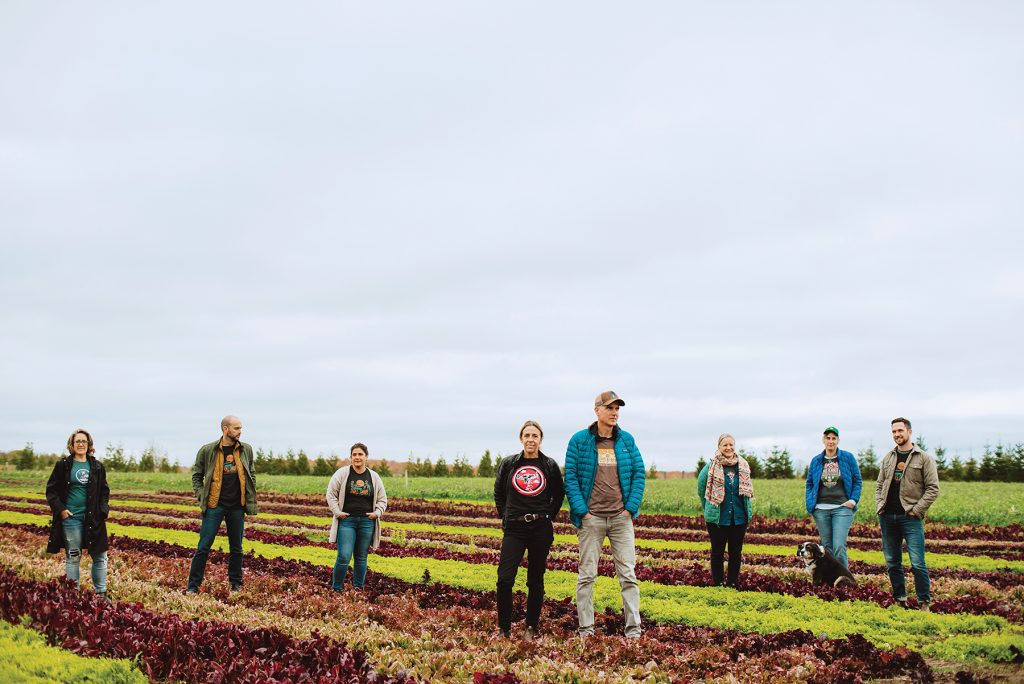
Farms for Change
Rainbow beets, heirloom potatoes and gourmet salad greens may fill The New Farm’s fields, but it’s their Farms for Change fundraiser that fills the bellies of hundreds who might otherwise go without. As of this year, Farms for Change has raised and donated over a million dollars, used to purchase local, organic vegetables for the kitchens and programs of Community Food Centres Canada. Locally, donations are allocated to the Clearview Stayner Food Bank, Collingwood Salvation Army and clients of My Friend’s House women’s shelter. Farms for Change means increased access to healthy food while strengthening Ontario’s organic farms.
In the early days of The New Farm – a family run, certified organic farm in Creemore – owners Gillian Flies and Brent Preston found that their highly desirable vegetables were selling mainly to the one percent. This didn’t fit their goal of an equitable food system, so they began donating produce to The Stop Community Food Centre in Toronto. However, those efforts weren’t sustainable. “We didn’t have any money and the business was losing money hand over fist,” says Preston. “We couldn’t give away vegetables and keep the farm going.” So the couple came up with an alternative. “We looked around our amazing community and decided to throw a party at the farm with organic food and music to raise money that could buy vegetables from our farm to send to The Stop,” says Flies.
In its first year in 2010, Farms for Change sold 200 tickets and raised $15,000. The party was a success and over the next decade it grew to include 20 chefs (all donating their time), 75 volunteers, and top Canadian bands who charged only to transport their instruments. “I will never forget having The Hip on the stage in the barn, playing their incredible, iconic songs,” says Preston of Canadian rock band The Tragically Hip, who graced the stage months before frontman Gord Downey was diagnosed with brain cancer.
The event space (barn, barnyard and fields) holds a maximum of 1,000 people and each year that many tickets sell within minutes, translating to over $100,000 raised annually. Farms for Change has become a community tradition, an incredible night surrounded by love, generosity and good food. But its impact reaches far beyond Southern Georgian Bay, says Flies. “If we have the skills, connections, space and community to help build the kind of world we want our children to grow up in, then we have an obligation to do it.”
And that world means a just, equitable and inclusive food system for all.
by Emily Worts
For more information, visit thenewfarm.ca
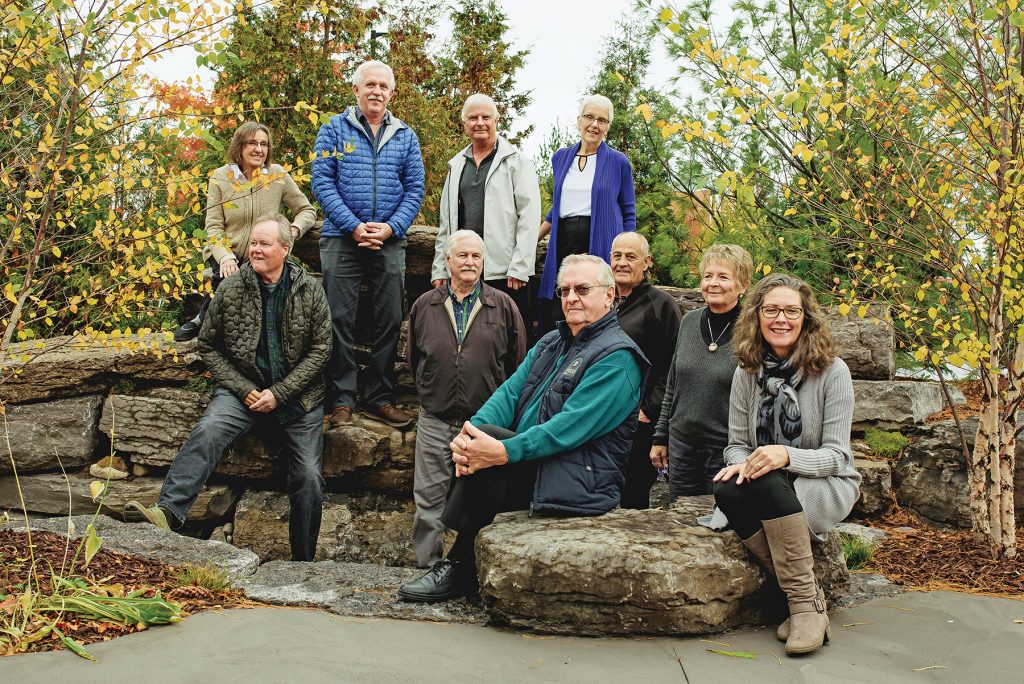
Hospice Georgian Triangle
When Hania Krajewski’s husband Michael spent his last three days of life at Campbell House after a long and difficult illness, the compassion and dignity extended to him, and to Hania as the exhausted caregiver, was so heartwarming that, she recalls, “the knots in my tummy went away for the first time in years. The experience really healed something in me.”
This essential service provided free to our community could only exist because of Hospice Georgian Triangle (HGT), which operates this very special palliative care residence. Campbell House opened in August 2014 with six private patient suites, a full kitchen, large living area and quiet lounges (an additional four residential suites have since been added, and HGT is currently working with the Local Health Integration Network to make these available). Over the past five years, more than 800 patients and their families have been cared for at Campbell House, with an average stay of nine days.
A registered charity, Hospice Georgian Triangle was formed in 1987 as an all-volunteer visiting program providing non-medical support to those living with a life-threatening illness or at the end of life. The goal of the original founders was to provide better end-of-life care in our community for both patients and their families. This was initially achieved through home visits and eventually two respite suites in the Collingwood General & Marine Hospital and later at Sunset Manor. Since the beginning the goal and purpose was to have a permanent hospice home, and after much fundraising activity, that goal was achieved when Campbell House opened its doors. Today, HGT continues to provide home visits by trained volunteers, but the main focus is running and maintaining Campbell House, which provides professional clinical care 24 hours a day.
It’s a major effort that requires a great deal of community support. “We have to raise $1.1 million this year to meet our operating budget,” says Janet Fairbridge, director of the Hospice Georgian Triangle Foundation (the fundraising arm). “We receive some funding from the Ministry of Health, but the majority of our financial support comes from community events, donations, and increasingly from third-party events. And we depend on volunteers. Volunteers are required to organize and run the annual events like The Hospice Care Gala, The Hike and Bike, and The Curling Bonspiel. As well, both the foundation board and the hospice board are volunteers. These people are definitely the backbone of our organization.”
In addition to the professional staff, more than 130 active volunteers spend time at Campbell House, giving this welcoming space its atmosphere of compassion and warmth. Volunteers dubbed “The Kitchen Angels” provide food all day long for visitors and families, from soup and sandwiches to home-baked snacks. Trained volunteers also provide companionship to allow family members respite and to offer vigil support. Other volunteers are on hand to welcome visitors at the reception desk, play the piano, or help keep the gardens tended. “The volunteers are what make it possible for us to provide support for the family,” says Fairbridge. “When a patient comes to Campbell House, we want the family to be able to focus on being a family.” And this circle of care makes the circle of life that much sweeter.
by Judy Ross
For more information, visit hospicegeorgiantriangle.com
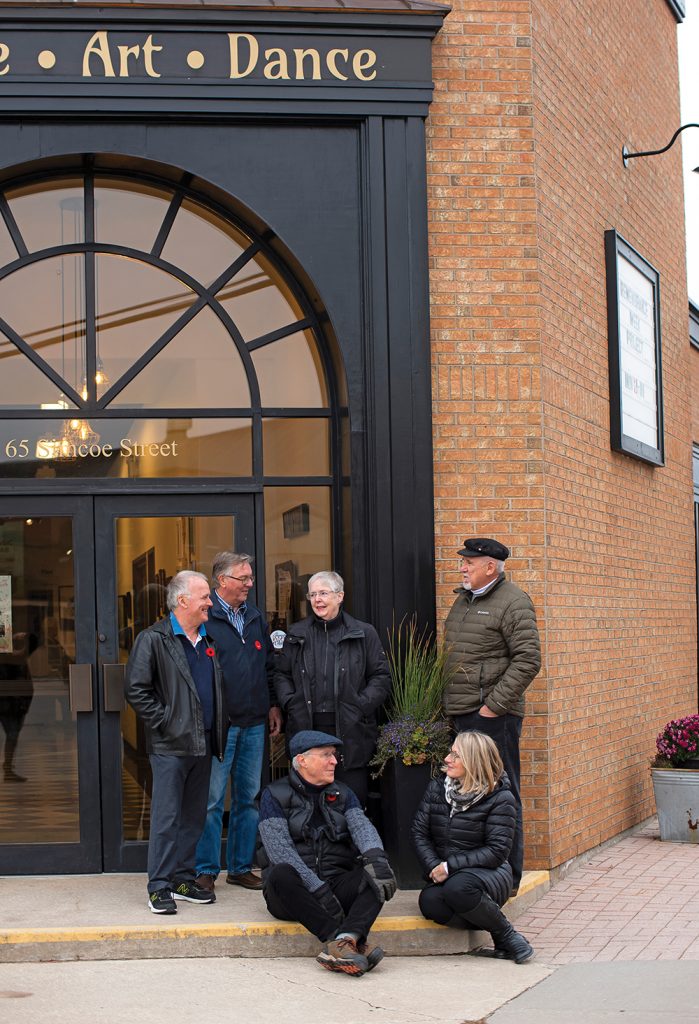
The Georgian Triangle
Lifelong Learning Institute
As a learning organization for adults, the Georgian Triangle Lifelong Learning Institute (GTLLI) is committed to expanding awareness of the wider world. And now, thanks to technology, the GTLLI is reaching an even wider audience.
Founded in 1996 by a handful of local enthusiasts, the GTLLI has grown to more than 1,100 members today. But the New Life Church in Collingwood, where the live sessions are held, can only seat about 400 people. With regional population growth, an influx of more retired and semi-retired people, and increased interest from all age groups, the fall, winter and spring lecture series have sold out quickly in recent years, leaving many unable to get tickets.
To keep up with demand, this year the GTLLI has begun livestreaming the lectures to three additional locations across Southern Georgian Bay: the Simcoe Street Theatre in Collingwood, Station on the Green in Creemore and the RecPlex in Wasaga Beach. The lectures are also professionally recorded, with videos available online to view on your TV, computer, tablet or phone at any time.
“We’re finding that the livestream venues are proving very popular, because people can come in and still have the social aspect and discussion at the coffee break,” says chair Sarah Dennis, adding the GTLLI has sold about 170 tickets to the livestreamed lectures so far. Meanwhile, the videos are reaching out to people who are not yet retired and may be unable to attend the live or livestreamed lectures on Friday mornings, but still want to absorb the content. “We also have a lot of interest from retirement homes wanting to access the videos, as well as some high schools,” adds Dennis.
The fall lecture series dealt with fascinating aspects of the brain, the winter series focuses on water issues in Ontario, and the spring lectures will look at Canadian foreign policy from 1968 to today, “basically from Pierre Trudeau to Justin Trudeau.” In each series, the calibre of the material is extremely high. “These are university-level lectures by university professors and experts,” says Dennis, adding, “We’re so impressed by the quality of educated seniors in this area, all very interested in all different types of topics, who have really thoughtful questions. We want to make complex issues really understandable for everyone, and keep the discussion going.”
In the words of Nelson Mandela, “Education is the most powerful weapon which you can use to change the world.” And by that standard, the GTLLI is helping to make our community an ever more powerful force for change, at every age.
by Janet Lees
For more information, visit gtlli.ca
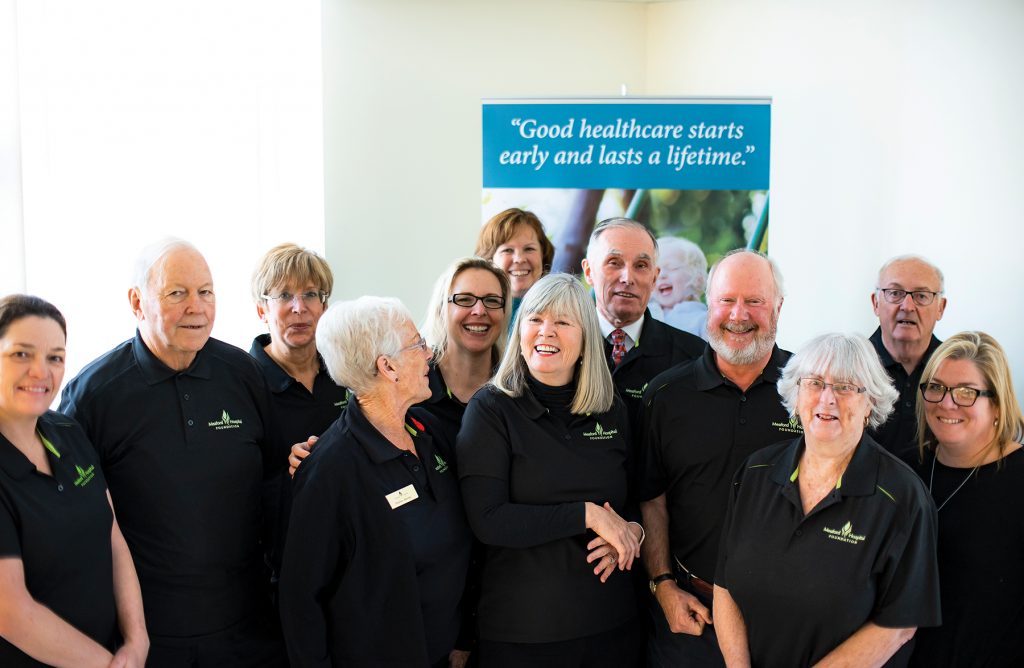
Meaford Hospital Foundation
With cutbacks to government funding, providing state-of-the-art healthcare can be a challenge in rural communities. That’s where the Meaford Hospital Foundation comes in, raising funds for new and replacement medical equipment at the Meaford Hospital and Owen Sound Regional Hospital to keep high-quality healthcare close to home.
“Rural hospitals are well equipped to do a number of things, and we do an amazing number of things, but we also need to support the regional hospitals around us,” says Barbara Little, chair of the Meaford Hospital Foundation (MHF). “That’s why we have really focused this year on two main areas. One is the purchase of the new MRI for the Owen Sound hospital – we’ve raised over a quarter of a million dollars for that – and we have also just completed a commitment to our hospitals for mental health.”
Through its 23rd Annual Meaford Harbour Run/Walk, the MHF this year raised more than $100,000 in one day for the Owen Sound hospital’s mental health unit as well as providing a safe room at Meaford Hospital for patients being assessed. “From MRIs to mental health, that has been pretty much our focus. We also have about 15 other items on our local hospital list that we’re looking at funding over the next couple of years,” says Little. “Our goal really is to make sure that our hospitals stay state-of-the-art in terms of equipment. The government funds the bricks and mortar part of hospitals and the salaries, but after the hospital is built, if there are improvements to be made, it is up to the community to go out and fund those things.”
Little refers to Meaford Hospital as a “boutique hospital,” but a staggering number of patients come through its doors each year. “Last year saw over 4,000 inpatient days in the hospital, with an average length of stay of six days; our emergency department visits last year were over 11,000; we had over 1,000 surgery visits to our hospital; and we had over half a million lab procedures.” The average age of inpatients is 74, but Little is quick to add that the hospital services area residents of all ages, plus visitors to the area and the local military base.
“With our population growth, the needs on the hospital are growing all the time, and there are many ways people can ensure that this hospital stays up to date: through a one-time or monthly pledge, through legacy giving, through event sponsorship and support, and through volunteering. Our volunteers are so important to us, and our dream would be that we have an unlimited number of volunteers. The number one dream is that our hospital is secured, that we are never going to have a moment where we have to worry about whether or not the funding will be there to keep the hospital viable.”
by Janet Lees
For more information, visit mhfoundation.ca











